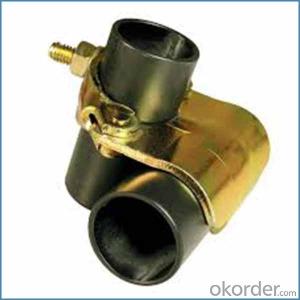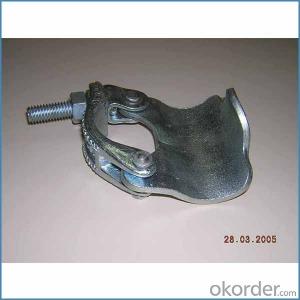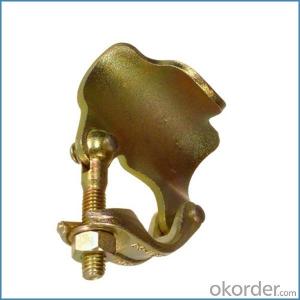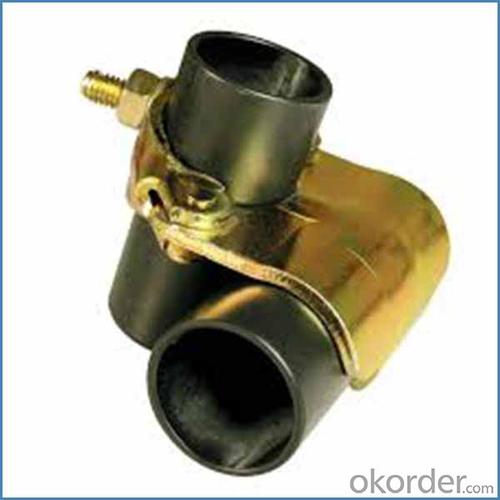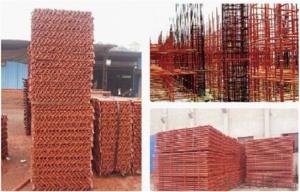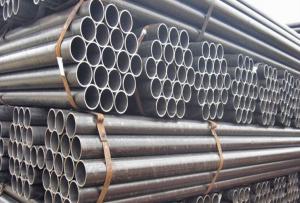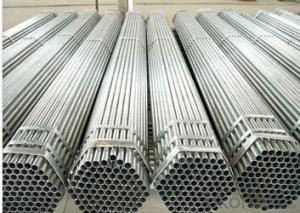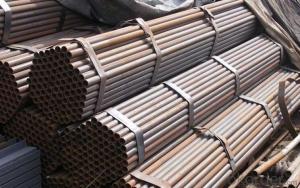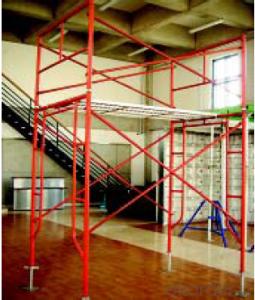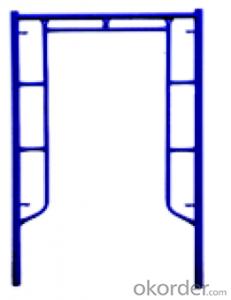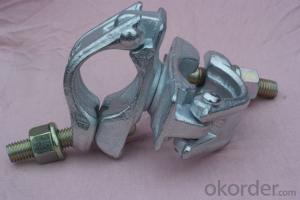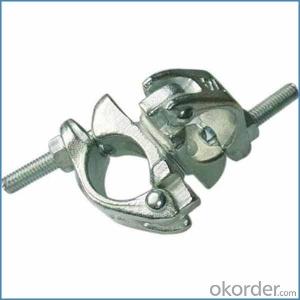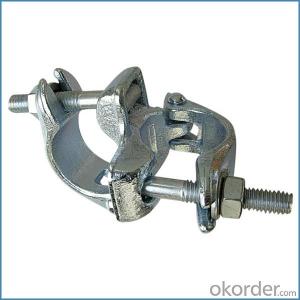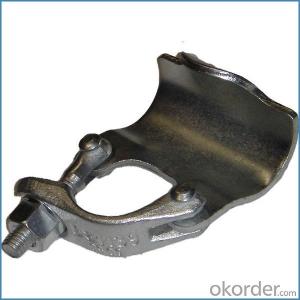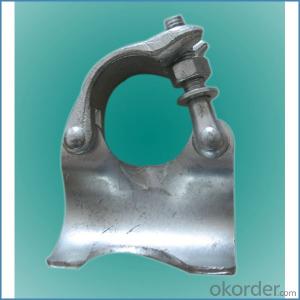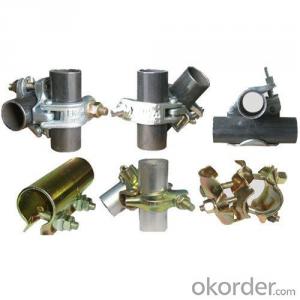Construction Scaffolding Clamps british German Forged Type
- Loading Port:
- Tianjin
- Payment Terms:
- TT OR LC
- Min Order Qty:
- 1000 kg
- Supply Capability:
- 100000 kg/month
OKorder Service Pledge
OKorder Financial Service
You Might Also Like
Construction Scaffolding Clamps british German Forged Type
Description
1.The scaffolding coupler is always used to connect the steel pipe as scaffolding system.
2.The often used coupler is swivel coupler and righ angle coupler .
3.We can provide types of scaffolding coupler according to your requirement.
4.Couoler can fix the 48.3mm scaffolding steel pipe tightly and make the whole scaffolding system more steadily.
Feature
(1)Excellent Anti-Breaking—Cold Pressed Steel
(2)Outstanding Resistance Deformation
(3)Strong Anti-Dropping Ability
Photo
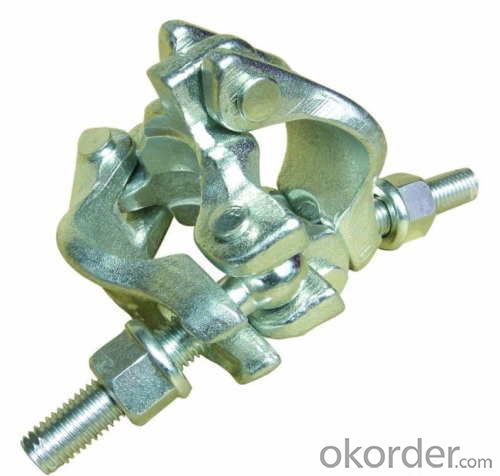
Parameter
| Material | Q235,345steel |
| Size | 48.3mm*48.3mm |
| Surface finish | Galvanized |
| Weight | 1.1kg around |
| Standard | BS1139,EN74 |
| Package | 25pcs/bag,steel pallet |
| Manufacture | As per customer requirement |
| Market | Africa, South America, the Middle East and Asia |
FAQ
Q: Are you a factory or trading company?
We are a state-owned corporation in China,dealing with various kinds of building materials.We have our holding subsidiaries.
Q: Where is your factory located? How can I visit there?
Our factory is located all around China.
Q: Can I get some samples?
Sample is free, customer only pay freight for the first time.
Q: Delivery?
10-30days. (5-15 containers)
Any question,feel free to contact us.
- Q: Are steel tube couplers easy to assemble and disassemble?
- Yes, steel tube couplers are generally easy to assemble and disassemble. They are designed to provide a secure and reliable connection between two steel tubes, allowing for easy joining and separation when needed. The assembly process usually involves inserting the tubes into the coupler, tightening the fasteners, and ensuring a tight fit. Disassembling the coupler is similarly straightforward and can be done by loosening the fasteners and removing the tubes. Overall, steel tube couplers offer a convenient and efficient solution for joining and separating steel tubes in various applications.
- Q: Can steel tube couplers be used in scaffolding projects with limited ground support?
- Yes, steel tube couplers can be used in scaffolding projects with limited ground support. Steel tube couplers are designed to connect steel tubes and provide a secure and stable connection. They offer excellent load-bearing capabilities and can withstand the weight and demands of scaffolding structures. However, it is essential to carefully assess the specific site conditions and ensure that appropriate measures are taken to ensure stability and safety in areas with limited ground support.
- Q: Are there any specific considerations for using steel tube couplers in scaffolding that will be used in high-wind areas?
- Yes, there are specific considerations for using steel tube couplers in scaffolding that will be used in high-wind areas. When constructing scaffolding in locations prone to high winds, it is crucial to ensure the stability and safety of the structure. Steel tube couplers play a vital role in securing the integrity of scaffolding, but additional measures must be taken in high-wind areas. Firstly, it is important to select steel tube couplers that are specifically designed and manufactured to withstand high winds. These couplers should have a high load-bearing capacity and be able to resist the forces imposed by strong winds. Couplers made from high-quality materials, such as galvanized steel, are recommended for their durability and weather resistance. Secondly, the installation of steel tube couplers should be done meticulously, following proper procedures and guidelines. The couplers should be securely fastened to the tubes, ensuring a tight fit and preventing any movement or loosening due to wind forces. It is advisable to use additional reinforcement techniques, such as bracing or tie-downs, to further enhance the stability of the scaffolding. Furthermore, the overall design and configuration of the scaffolding system should be carefully evaluated. In high-wind areas, it may be necessary to incorporate additional cross-bracing or diagonal members to provide extra rigidity and resistance against wind loads. The scaffolding structure should be engineered to withstand the anticipated wind speeds and forces, taking into account factors such as height, exposure, and local wind patterns. Regular inspections and maintenance are also essential when using steel tube couplers in high-wind areas. Inspections should be conducted before and after extreme weather events to ensure the integrity of the scaffolding system. Any signs of damage or wear should be promptly addressed, and couplers should be replaced if necessary. In conclusion, using steel tube couplers in scaffolding for high-wind areas requires specific considerations to ensure the stability and safety of the structure. Selecting appropriate couplers, following proper installation procedures, reinforcing the scaffolding system, and conducting regular inspections are all crucial steps to mitigate the potential risks associated with high winds.
- Q: why scaffolds need to be inspected within the preeceding 7 days and after adverse weather condition?
- Inspection is the best way to save lives on the scaffolds.
- Q: According to the "construction of fasteners steel scaffold safety technical specifications", the structure of the pole which
- There are many kinds of insulation materials, the process is not the same
- Q: What are the different finishes available for steel tube couplers?
- There are several finishes available for steel tube couplers, including galvanized, painted, powder-coated, and bare metal. Galvanized finishes provide a protective layer against corrosion, while painted and powder-coated finishes offer aesthetic appeal and additional protection. Bare metal finishes are also an option, but they may require regular maintenance to prevent rusting.
- Q: What are the recommended torque specifications for tightening steel tube couplers?
- The recommended torque specifications for tightening steel tube couplers can vary depending on the specific type and size of the coupler being used. It is important to refer to the manufacturer's guidelines and specifications for the specific coupler being installed. Generally, torque specifications for steel tube couplers range from 15 to 30 foot-pounds (20 to 40 Newton-meters). It is important to use a torque wrench to ensure accurate and consistent torque application, as over-tightening can lead to damage or failure of the coupler, while under-tightening can result in leaks or insufficient joint strength. Always follow the manufacturer's recommendations and guidelines to ensure proper installation and performance of steel tube couplers.
- Q: What are the common challenges in using steel tube couplers in scaffolding?
- There are several common challenges that can arise when using steel tube couplers in scaffolding. Firstly, one challenge is ensuring proper installation and alignment of the couplers. The couplers need to be securely attached to the tubes and properly aligned to ensure stability and safety. This requires careful attention to detail and expertise in scaffolding assembly. Secondly, rust and corrosion can be a significant challenge when using steel tube couplers. Steel is susceptible to rust and if the couplers are not properly coated or maintained, they can deteriorate over time. This can compromise the integrity of the scaffolding structure and pose a safety risk. Regular inspection and maintenance, as well as using corrosion-resistant coatings, can help mitigate this challenge. Another challenge is the weight and size of the couplers. Steel tube couplers can be heavy and bulky, making them difficult to handle and transport. This can increase the time and effort required for scaffolding assembly and disassembly. Additionally, the weight of the couplers can put strain on the scaffolding structure, requiring careful consideration of load capacities and weight distribution. Additionally, compatibility with different tube sizes can be a challenge. Steel tube couplers come in various sizes to accommodate different tube diameters, but ensuring the right fit can be challenging. It is important to select couplers that are compatible with the specific tubes being used and to carefully follow manufacturer guidelines for installation. Lastly, cost can be a challenge when using steel tube couplers. Steel is generally more expensive than other materials used in scaffolding, such as aluminum or plastic. This can increase overall project costs, particularly for larger scaffolding structures. Overall, while steel tube couplers are commonly used in scaffolding due to their strength and durability, they come with their own set of challenges. Proper installation, maintenance, rust prevention, handling, compatibility, and cost considerations are crucial to ensuring safe and efficient scaffolding operations.
- Q: How do steel tube couplers affect the overall cost of scaffolding projects?
- Steel tube couplers can have a significant impact on the overall cost of scaffolding projects. These couplers are essential components that connect the steel tubes, forming a sturdy and reliable structure. The cost of steel tube couplers can vary depending on factors such as the type and quality of the couplers, the quantity needed, and the supplier. One aspect that affects the cost is the type of steel tube couplers used. There are various types available, including swivel couplers, sleeve couplers, putlog couplers, and beam clamps. Each type has its own specifications, applications, and cost. For example, swivel couplers are typically more expensive than sleeve couplers due to their added flexibility and adjustable features. The quality of the steel tube couplers also plays a role in the overall cost. High-quality couplers are typically more expensive but offer better durability, strength, and resistance to corrosion. Investing in superior quality couplers can lead to longer-lasting scaffolding structures, reducing the need for frequent replacements and maintenance, thus potentially lowering overall costs in the long run. The quantity of steel tube couplers needed for a particular project directly affects the cost. Large-scale projects that require a significant amount of scaffolding will naturally require a greater number of couplers, resulting in higher costs. It is essential to accurately estimate the quantity needed to avoid over-purchasing and unnecessary expenses. Lastly, the choice of supplier can impact the cost of steel tube couplers. Different suppliers may offer varying prices for identical or similar products. It is crucial to research and compare prices from multiple suppliers to ensure that the best value for money is obtained. Overall, steel tube couplers can significantly affect the cost of scaffolding projects. Factors such as the type, quality, quantity, and supplier of the couplers should be carefully considered to optimize costs while maintaining the required safety and reliability of the scaffolding structure.
- Q: Do steel tube couplers require any additional safety measures during installation?
- During the installation of steel tube couplers, it may be necessary to implement additional safety measures in order to guarantee proper installation and prevent potential hazards. Some of the possible safety measures that could be required include the following: 1. Personal Protective Equipment (PPE): It is important for installers to wear appropriate PPE, such as gloves, safety glasses, and steel-toe boots, to protect themselves from potential injuries or accidents. 2. Training and Certification: Installers should receive adequate training and certification in the correct installation techniques and safety procedures for steel tube couplers. This will help prevent any errors or mistakes during installation that could compromise safety. 3. Inspection and Testing: Prior to installation, it is crucial to inspect the steel tube couplers for any defects or damage that could impact their performance or safety. Additionally, it is essential to test the couplers to ensure they meet the required strength and performance standards. 4. Proper Handling and Storage: Steel tube couplers should be handled and stored in a manner that prevents damage or deformation. Mishandling or dropping couplers can compromise their structural integrity and safety. 5. Secure Installation: Couplers must be properly aligned and securely fastened to withstand the intended loads and forces. It is vital to adhere to the manufacturer's guidelines and specifications during installation to ensure proper performance and safety. 6. Supervision and Quality Control: Having a supervisor or quality control personnel oversee the installation process can guarantee that all safety measures are correctly followed and that the installation is carried out properly. By implementing these additional safety measures, the risk of accidents, injuries, or structural failures during the installation of steel tube couplers can be minimized, resulting in a safe and reliable installation.
Send your message to us
Construction Scaffolding Clamps british German Forged Type
- Loading Port:
- Tianjin
- Payment Terms:
- TT OR LC
- Min Order Qty:
- 1000 kg
- Supply Capability:
- 100000 kg/month
OKorder Service Pledge
OKorder Financial Service
Similar products
Hot products
Hot Searches
Related keywords
